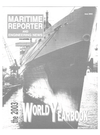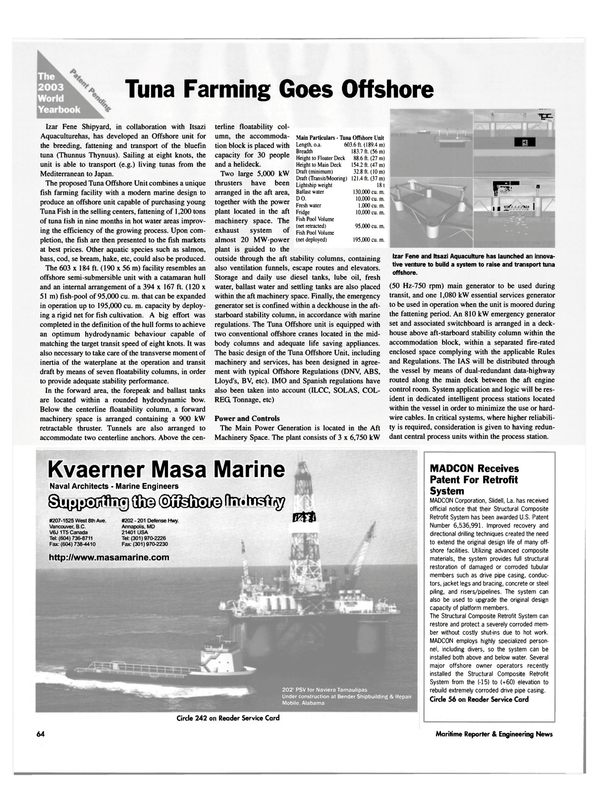
Tuna Farming Goes Offshore
Izar Fene Shipyard, in collaboration with Itsazi Aquaculturehas, has developed an Offshore unit for the breeding, fattening and transport of the bluefin tuna (Thunnus Thynuus). Sailing at eight knots, the unit is able to transport (e.g.) living tunas from the Mediterranean to Japan.
The proposed Tuna Offshore Unit combines a unique fish farming facility with a modern marine design to produce an offshore unit capable of purchasing young Tuna Fish in the selling centers, fattening of 1,200 tons of tuna fish in nine months in hot water areas improving the efficiency of the growing process. Upon completion, the fish are then presented to the fish markets at best prices. Other aquatic species such as salmon, bass, cod, se bream, hake, etc, could also be produced.
The 603 x 184 ft. (190 x 56 m) facility resembles an offshore semi-submersible unit with a catamaran hull and an internal arrangement of a 394 x 167 ft. (120 x 51m) fish-pool of 95,000 cu. m. that can be expanded in operation up to 195,000 cu. m. capacity by deploying a rigid net for fish cultivation. A big effort was completed in the definition of the hull forms to achieve an optimum hydrodynamic behaviour capable of matching the target transit speed of eight knots. It was also necessary to take care of the transverse moment of inertia of the waterplane at the operation and transit draft by means of seven floatability columns, in order to provide adequate stability performance.
In the forward area, the forepeak and ballast tanks are located within a rounded hydrodynamic bow.
Below the centerline floatability column, a forward machinery space is arranged containing a 900 kW retractable thruster. Tunnels are also arranged to accommodate two centerline anchors. Above the cen- terline floatability column, the accommodation block is placed with capacity for 30 people and a helideck.
Two large 5,000 kW thrusters have been arranged in the aft area, together with the power plant located in the aft machinery space. The exhaust system of almost 20 MW power plant is guided to the outside through the aft stability columns, containing also ventilation funnels, escape routes and elevators.
Storage and daily use diesel tanks, lube oil, fresh water, ballast water and settling tanks are also placed within the aft machinery space. Finally, the emergency generator set is confined within a deckhouse in the aftstarboard stability column, in accordance with marine regulations. The Tuna Offshore unit is equipped with two conventional offshore cranes located in the midbody columns and adequate life saving appliances.
The basic design of the Tuna Offshore Unit, including machinery and services, has been designed in agreement with typical Offshore Regulations (DNV, ABS, Lloyd's, BV, etc). IMO and Spanish regulations have also been taken into account (ILCC, SOLAS, COLREG, Tonnage, etc) Power and Controls The Main Power Generation is located in the Aft Machinery Space. The plant consists of 3 x 6,750 kW (50 Hz-750 rpm) main generator to be used during transit, and one 1,080 kW essential services generator to be used in operation when the unit is moored during the fattening period. An 810 kW emergency generator set and associated switchboard is arranged in a deckhouse above aft-starboard stability column within the accommodation block, within a separated fire-rated enclosed space complying with the applicable Rules and Regulations. The IAS will be distributed through the vessel by means of dual-redundant data-highway routed along the main deck between the aft engine control room. System application and logic will be resident in dedicated intelligent process stations located within the vessel in order to minimize the use or hardwire cables. In critical systems, where higher reliability is required, consideration is given to having redundant central process units within the process station.
The number and O. size of the vari- able speed azimuthing t h r u s t e r s installed (2 x 5,000 kW aft and 1 x 900 kW forward), are thought to be sufficient at this preliminary phase, and should be confirmed by resistance and propulsion test to be performed at a later stage in a Towing Basin in calm waters.
Marine Systems The Tuna Offshore Unit is equipped with all the necessary systems to make the unit intrinsically safe and seaworthy.
The bilge system, in combination with the Ballast system, allows the drainage of liquids confined in any watertight compartment. Four 1,000 cu. m. /h are installed for this purpose, capable of deballasting the unit in 33 hours.
Two independent electrically driven fire pumps and one diesel driven fire pump are installed to satisfy the seawater fire fighting system requirements.
A 10,000 kg/h - 7 kg/sq.m. steam generator for recovery of the exhaust residual heat of one main generator during transit and the essential services generator in the mooring period, is installed within the aft starboard stability column.
The boiler, is made of two sections to be used depending on the steam demand.
One of the sections of the boiler is provided with a fuel oil burning system that is used during the heating process of the main generators. The steam is used onboard for the various diesel oil tanks heating, bilge separators, oil purifiers, sea chests heating, accommodation services water heating, etc.
HVAC systems comprise ventilation of the machinery spaces to satisfy both health and comfort requirements.
Ventilation air is conducted into the aft machinery space through the port stability column. The main and essential services generators take the air necessary for their operation directly from the machinery space, being necessary an important ventilation flow to satisfy the oxygen demand during transit. Twelve propellers providing 500,000 cu.m. /h of fresh air and 10 extractors, are situated in deck houses in the aft starboard and port stability columns to ensure 15 renovations of the machinery spaces and escape routes through the aft stability columns. A 30,000 Kcal/h high speeddouble way air conditioning system is available within the accommodation block. Conventional power plant auxiliaries (lubricating, DO transfer, separator, refrigeration, etc) are arranged within the aft machinery as appropriated.
A corrosion protection life up to 20 years could be implemented following offshore standard practices to be achieved through a combination of painting and Aluminium based cathodic anode systems. Thirty kg anodes are installed in the submerged area and ballast tanks, while five kg anodes are used in the splash zone. The unit is outfitted with the following mooring systems.
• Three 15,400 kg high resistance forward anchors, being one spare.
• Three Two 9 0 0 m chains, allowing the mooring to be performed in water depths of 150 m during the fattening process.
• Three One 3 0 0 m - 1 5 0 t towing cable.
• Three Eight 200 - 4 4 t wire mooring ropes.
• Three Mooring and Towing Brackets as appropriated.
Circle 83 on Reader Service Card
Read Tuna Farming Goes Offshore in Pdf, Flash or Html5 edition of June 2003 Maritime Reporter
Other stories from June 2003 issue
Content
- SS Norway Boiler Room Explosion Claims Seven Lives page: 3
- 95th Anniversary of the Burning of General Slocum page: 8
- Color Line Builds IT Environment With SIS page: 12
- BASS Provides New CrewNet Version page: 12
- Inmarsat Launch New Fleet Services page: 16
- Northrop Grumman Completes Builder's Trials on USS Ronald Reagan page: 17
- AIS - Panacea or Pandora's Box page: 18
- Government Update page: 20
- Seabulk Contracts for PSV in Brazil page: 22
- A.K. Suda Designed Crew/Supply Boat Carries More for Less page: 24
- Seminar Series Aims to Ensure Compliance page: 26
- NOAA Ship Whiting Decommissioned After 3 9 Years Of Service page: 29
- Enter the LNG-Fueled Supply Ship page: 30
- Triple Delivery for FBM Babcock Marine page: 31
- Innovative Propulsion System for Ferry page: 32
- America's Super Liner to Set Sail Once Again? page: 34
- Bulker Water Ingress Alarms page: 40
- Bulkers Shaped by Regulations? page: 40
- Prestige - A Charterer's Reaction page: 44
- U.S. Shipbuilding 2003: A Congested Attempt to Fund page: 48
- Littoral Combat Ship Leads the Charge page: 54
- New FSPV Vessel Unveiled page: 62
- SSS: Separate Storage Shuttling page: 62
- Tuna Farming Goes Offshore page: 64
- NOx Emissions from Merchant Ships page: 68
- Salvage Posture Changing With The Times page: 73
- A Step Forward For Thick Section Plate Cutting page: 77


